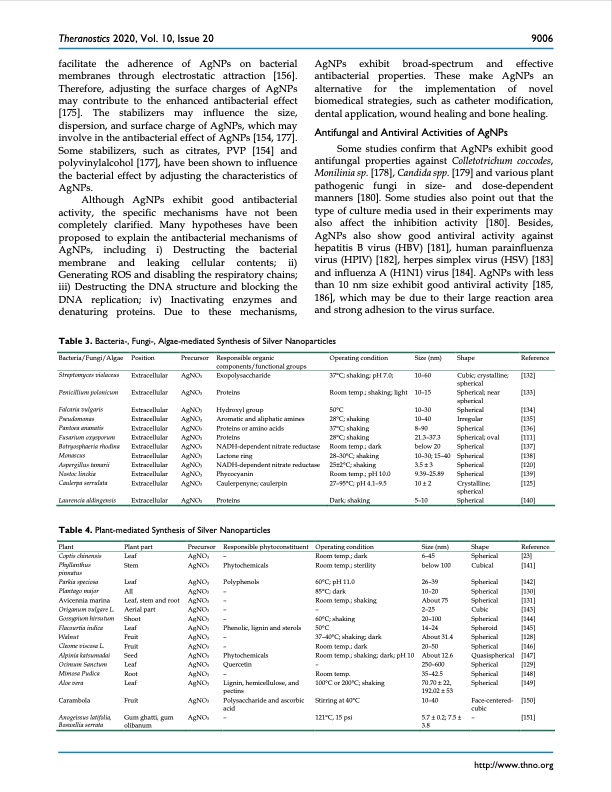
PDF Publication Title:
Text from PDF Page: 011
Theranostics 2020, Vol. 10, Issue 20 facilitate the adherence of AgNPs on bacterial membranes through electrostatic attraction [156]. Therefore, adjusting the surface charges of AgNPs may contribute to the enhanced antibacterial effect [175]. The stabilizers may influence the size, dispersion, and surface charge of AgNPs, which may involve in the antibacterial effect of AgNPs [154, 177]. Some stabilizers, such as citrates, PVP [154] and polyvinylalcohol [177], have been shown to influence the bacterial effect by adjusting the characteristics of AgNPs. Although AgNPs exhibit good antibacterial activity, the specific mechanisms have not been completely clarified. Many hypotheses have been proposed to explain the antibacterial mechanisms of AgNPs, including i) Destructing the bacterial membrane and leaking cellular contents; ii) Generating ROS and disabling the respiratory chains; iii) Destructing the DNA structure and blocking the DNA replication; iv) Inactivating enzymes and denaturing proteins. Due to these mechanisms, 9006 AgNPs exhibit broad-spectrum and effective antibacterial properties. These make AgNPs an alternative for the implementation of novel biomedical strategies, such as catheter modification, dentalapplication,woundhealingandbonehealing. Antifungal and Antiviral Activities of AgNPs Some studies confirm that AgNPs exhibit good antifungal properties against Colletotrichum coccodes, Monilinia sp. [178], Candida spp. [179] and various plant pathogenic fungi in size- and dose-dependent manners [180]. Some studies also point out that the type of culture media used in their experiments may also affect the inhibition activity [180]. Besides, AgNPs also show good antiviral activity against hepatitis B virus (HBV) [181], human parainfluenza virus (HPIV) [182], herpes simplex virus (HSV) [183] and influenza A (H1N1) virus [184]. AgNPs with less than 10 nm size exhibit good antiviral activity [185, 186], which may be due to their large reaction area and strong adhesion to the virus surface. Table 3. Bacteria-, Fungi-, Algae-mediated Synthesis of Silver Nanoparticles Bacteria/Fungi/Algae Streptomyces violaceus Penicillium polonicum Falcaria vulgaris Pseudomonas Pantoea ananatis Fusarium oxysporum Botryosphaeria rhodina Monascus Aspergillus tamarii Nostoc linckia Caulerpa serrulata Laurencia aldingensis Position Extracellular Extracellular Extracellular Extracellular Extracellular Extracellular Extracellular Extracellular Extracellular Extracellular Extracellular Extracellular Precursor AgNO3 AgNO3 AgNO3 AgNO3 AgNO3 AgNO3 AgNO3 AgNO3 AgNO3 AgNO3 AgNO3 AgNO3 Responsible organic components/functional groups Exopolysaccharide Proteins Hydroxyl group Aromatic and aliphatic amines Proteins or amino acids Proteins NADH-dependent nitrate reductase Lactone ring NADH-dependent nitrate reductase Phycocyanin Caulerpenyne; caulerpin Proteins Table 4. Plant-mediated Synthesis of Silver Nanoparticles Operating condition 37°C; shaking; pH 7.0; Room temp.; shaking; light 50°C 28°C; shaking 37°C; shaking 28°C; shaking Room temp.; dark 28–30°C; shaking 25±2°C; shaking Room temp.; pH 10.0 27–95°C; pH 4.1–9.5 Dark; shaking Operating condition Room temp.; dark Room temp.; sterility 60°C; pH 11.0 85°C; dark Room temp.; shaking – 60°C; shaking 50°C 37–40°C; shaking; dark Room temp.; dark Room temp.; shaking; dark; pH 10 – Room temp. 100°C or 200°C; shaking Stirring at 40°C 121°C, 15 psi Size (nm) 10–60 10–15 10–30 10–40 8–90 21.3–37.3 below 20 10–30; 15–40 3.5 ± 3 9.39–25.89 10 ± 2 5–10 Size (nm) 6–45 below 100 26–39 10–20 About 75 2–25 20–100 14–24 About 31.4 20–50 About 12.6 250–600 35–42.5 70.70 ± 22, 192.02 ± 53 10–40 Shape Cubic; crystalline; spherical Spherical; near spherical Spherical Irregular Spherical Spherical; oval Spherical Spherical Spherical Spherical Crystalline; spherical Spherical Shape Spherical Cubical Spherical Spherical Spherical Cubic Spherical Spheroid Spherical Spherical Quasispherical Spherical Spherical Spherical Face-centered- cubic – Reference [132] [133] [134] [135] [136] [111] [137] [138] [120] [139] [125] [140] Reference [23] [141] [142] [130] [131] [143] [144] [145] [128] [146] [147] [129] [148] [149] [150] [151] Plant Coptis chinensis Phyllanthus pinnatus Parkia speciosa Plantago major Avicennia marina Origanum vulgare L. Gossypium hirsutum Flacourtia indica Walnut Cleome viscosa L. Alpinia katsumadai Ocimum Sanctum Mimosa Pudica Aloe vera Carambola Anogeissus latifolia, Boswellia serrata Plant part Leaf Stem Leaf All Leaf, stem and root Aerial part Shoot Leaf Fruit Fruit Seed Leaf Root Leaf Fruit Gum ghatti, gum olibanum Precursor AgNO3 AgNO3 AgNO3 AgNO3 AgNO3 AgNO3 AgNO3 AgNO3 AgNO3 AgNO3 AgNO3 AgNO3 AgNO3 AgNO3 AgNO3 AgNO3 Responsible phytoconstituent – Phytochemicals Polyphenols – – – – Phenolic, lignin and sterols – – Phytochemicals Quercetin – Lignin, hemicellulose, and pectins Polysaccharide and ascorbic acid – 5.7 ± 0.2; 7.5 ± 3.8 http://www.thno.orgPDF Image | Silver nanoparticles Synthesis medical applications safety

PDF Search Title:
Silver nanoparticles Synthesis medical applications safetyOriginal File Name Searched:
thnov10p8996.pdfDIY PDF Search: Google It | Yahoo | Bing
Turbine and System Plans CAD CAM: Special for this month, any plans are $10,000 for complete Cad/Cam blueprints. License is for one build. Try before you buy a production license. More Info
Waste Heat Power Technology: Organic Rankine Cycle uses waste heat to make electricity, shaft horsepower and cooling. More Info
All Turbine and System Products: Infinity Turbine ORD systems, turbine generator sets, build plans and more to use your waste heat from 30C to 100C. More Info
CO2 Phase Change Demonstrator: CO2 goes supercritical at 30 C. This is a experimental platform which you can use to demonstrate phase change with low heat. Includes integration area for small CO2 turbine, static generator, and more. This can also be used for a GTL Gas to Liquids experimental platform. More Info
Introducing the Infinity Turbine Products Infinity Turbine develops and builds systems for making power from waste heat. It also is working on innovative strategies for storing, making, and deploying energy. More Info
Need Strategy? Use our Consulting and analyst services Infinity Turbine LLC is pleased to announce its consulting and analyst services. We have worked in the renewable energy industry as a researcher, developing sales and markets, along with may inventions and innovations. More Info
Made in USA with Global Energy Millennial Web Engine These pages were made with the Global Energy Web PDF Engine using Filemaker (Claris) software.
Infinity Turbine Developing Spinning Disc Reactor SDR or Spinning Disc Reactors reduce processing time for liquid production of Silver Nanoparticles.
| CONTACT TEL: 608-238-6001 Email: greg@infinityturbine.com | RSS | AMP |